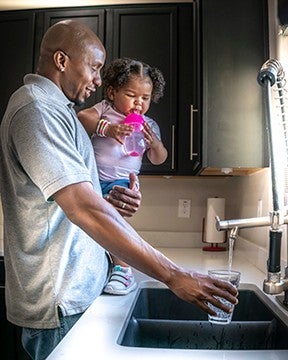Phoenix has launched a Citywide food drive to assist residents due to SNAP benefit interruptions.
Water Quality

Water quality - what Phoenix delivers every day.
Think about water. What would life be like in the desert without a reliable, safe supply of tap water?
Phoenix knows how important water is to your daily life, and the health and safety of your family. Every day we want you to know that delivering water with the highest level of quality is our biggest priority. And for more than 117 years, the city of Phoenix Water Services Department has made good on that priority.
We Stand Behind Every Drop
The city of Phoenix provides drinking water to more than 1.7 million people within our 540 square-mile service area. On average, about 95 percent of Phoenix's water comes from surface water (lakes and rivers) and the remaining water comes from groundwater (wells). Each May, the city distributes and posts to the web a Water Quality Report that contains important information about the quality of your water. Phoenix is committed to providing the highest quality drinking water and service to our customers.
Testing the Water to Ensure Only the Highest Quality
More than five million tests and measurements are conducted each year to ensure high quality tap water in Phoenix. It is tested for more than 100 substances, and is monitored throughout the year to ensure that it meets the rigorous standards set forth by the U.S. Environmental Protection Agency (EPA), the Arizona Department of Environmental Quality, and the Maricopa County Environmental Services Department.
From time to time various groups develop desired standards for drinking water that differ from those established by the EPA. While these theoretical standards may start with good intentions, comparing Phoenix's test results, which are in full compliance with EPA standards, to artificial standards can create confusing, incomplete, and many times extremely misleading information that is unfair to our customers and the city. Be assured that Phoenix complies with current EPA requirements, works with water associations to remain up to date on water quality standards and is committed to protecting public health and safety. Learn more about your water in the latest water quality report.
Water Treatment Process Provides Superior Drinking Water
Testing on tap water begins before it enters the water treatment plant. Plant staff works closely with laboratory technicians to determine the composition of the raw water that enters the plant so the treatment process can be fine tuned to ensure that the water is treated effectively to the highest standards. The water is monitored manually and electronically throughout the process to determine if adjustments to treatment must be made. The graphic below shows the basic treatment process at the Phoenix Water Treatment plants.
 Phoenix Water Treatment Process
Phoenix Water Treatment Process
More to Explore
-
FAQ
The City of Phoenix Water Services Department answers frequently asked questions about water and wastewater services.
-
Advanced Purified Water
Advanced Water Purification is a proven technology process that safely and efficiently purifies recycled wastewater into drinking water.
-
Water Quality Reports
Explore Phoenix's Water Quality Reports for detailed insights into water safety and standards, ensuring transparency and trust in your water supply.